Rick Newcombe
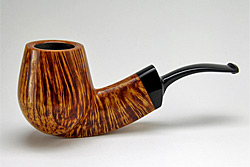 Karlheinz Joura is one of my favorite people in the pipe world. He is also a skilled artisan whose pipes are considered among the most beautiful and best smokers in the world.
Karlheinz Joura is one of my favorite people in the pipe world. He is also a skilled artisan whose pipes are considered among the most beautiful and best smokers in the world.
Known as Karlo to his friends and family, he has been making pipes from his workshop in Bremen, Germany, for more than 40 years. His dramatic personal story is unique among pipe makers today. Much has been written about Karlo’s life over the years, though many of the details have been left out of past reports. I have seen slight inaccuracies in some stories, including my own, due to translation issues, and I want to use this article to correct the record. For starters, there is his first name. We all assumed that "Heinz" was his middle name when in fact his first name is Karlheinz.
As a young man growing up in Rostock, which is in the northeastern part of Germany, Karlo was a terrific athlete and a phenomenal diver. He was born in Bohemia in 1942 in an area that is now the Czech Republic — one of many Germans who lived in that area. His birth occurred at the height of World War II. His family was forced to move out of the area in 1946 when he was 4 years old. They settled in Rostock without a penny to their names. Like so many refugees, they had to start over. After the war, Joseph Stalin had claimed all of East Germany as part of the Soviet Union, so Karlo grew up under rigid Communist control. It is hard to imagine what it was like growing up under two of the most ruthless dictators in human history — Adolph Hitler for his first four years and Joseph Stalin for the next 15.
By the time he was 19, in 1961, Karlo had become a diver on the German National Team. He and his teammate, Klaus Konzorr, spent four hours a day at diving practice and then worked the rest of the day as mechanics on the big ships in the harbor. They made a plan to escape to West Germany.
This was not easy. For starters, they had to pick the right ship to hide on. God forbid they were to hide on a ship headed to Russia or any of the Eastern bloc countries. Finally they decided on a West German cargo ship that would be sailing soon to Spain. They waited for a dark night when there was little moonlight, and there was a heavy fog.
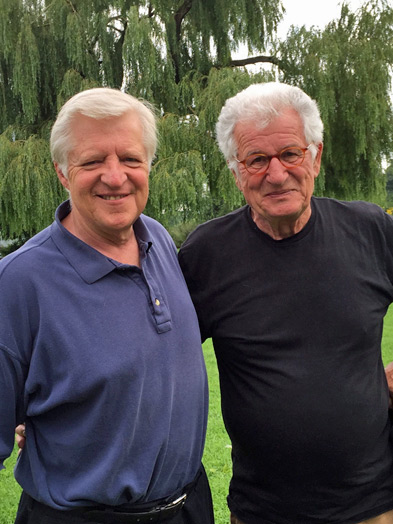
Two old pals: Rick Newcombe and Karlheinz Joura in 2015.
One speaks English and the other German, but their common language is pipes.
They hid quietly as two East German military personnel guarded the gangway, and at 3 a.m. they got their break. A group of West German sailors decided to leave the ship and visit Rostock to see if anything was going on in the city. The military guards left the gangway momentarily to fill out paperwork on the sailors leaving the ship. It was during that brief moment that Karlo and Klaus ran up to the ship, literally behind the backs of the guards, and managed to sneak on board. They had God on their side that night, because just as they started to sprint, a freight train very close to the ship was passing by and making a loud, thunderous noise.
The two young men knew their way around ships in general, but they had never been on this one. They went to the bowels of the ship, where they found the room with the motor on one side and the propellor on the other, a room that was 20 meters in length, or 65 feet. They squeezed into a very narrow tunnel that ran between the propellor shaft and the wall of the ship. They went to the back of the tunnel, where oil was leaking on the ground and it was pitch black except for a couple of emergency lights on the walls closer to the center.
Then the Stasi entered. The Stasi were East Germany’s secret police, connected to the Soviet KGB secret police and known for using torture tactics as a matter of routine. It sounded like a half-dozen of them, but Karlo was only guessing, because he couldn’t lift his head to see.
They had metal clicks on their boots, and Karlo and Klaus could hear them marching on the steel floor, looking for stowaways. Then one started walking down the tunnel, getting very close to where Karlo and Klaus were hiding. He appeared to be staring through the darkness, trying to see any movement, and Karlo worried that the man would see his silhouette or hear his breathing because he was so scared and trying desperately to hold his breath and to stand frozen. But the policeman stopped when he saw the oil slick on the ground. He didn’t want to step in it. He shouted to his comrades, "Nothing back here!" and they all gradually left the ship.
How did Karlo know what the man was thinking? "I just knew," he said more than a half-century later. “I could hear his boots on the steel floor as he approached us, and I heard him stop suddenly when he realized there was oil on the ground. It seemed pretty obvious that he wanted to avoid stepping in it."
After the Stasi left and the cargo ship departed from shore, Karlo and Klaus waited for several hours before finally emerging on deck. They figured that by now they were in international waters and safe from capture by the Communists.
Two years later Martin Luther King would make his famous "I have a dream" speech at the Lincoln Memorial in which he concluded by shouting, "Free at last! Free at last! Thank God Almighty, we are free at last!" And that is exactly how Karlo and Klaus felt when they were standing on deck breathing in the sea air in international waters, experiencing real freedom for the first time in their lives.
The Berlin Wall had only recently been built, and Karlo had managed to get out before the Stasi seriously tightened the screws. For instance, one of Karlo’s best friends, Hans-Joachim Frommhold, nicknamed "Frommi,” was only 16 when he tried the same escape a short while later. He boarded a West German ship, hid in the tunnel below deck, and was given assistance by two young West Germans who were working on the ship. They were discovered, and all three were sentenced to six-month prison terms. Frommi, who also was a champion diver — in fact, Karlo says he was the most talented diver on the team — was banned from athletics for life. As if that were not enough, after he had served his prison term, he was sentenced for another year to endure additional hardships such as cleaning the latrines on ships and other humiliating jobs.
In 2014, Karlo attended a conference at the old Stasi headquarters in Rostock and sat enthralled as his old friend and the two West Germans told of their experiences in the Stasi prison. Karlo showed me their police mug shots, and you can see how handsome they were, and how scared. They also looked brave, strong and determined.

These police mug shots were taken at the Stasi prison in 1962. The top row shows Hans-Joachim Frommhold, the East German diver who was a close friend of Joura’s, after he was caught trying to escape to West Germany. He was only 16 at the time of his arrest. The bottom photos show the two West German shipmates — Horst Hülden and Manfred Krupski — who were caught trying to help him escape.
Before the Wall finally came down in 1989, Karlo did manage to see his family in Prague, but only by experiencing terror at each checkpoint when returning home to Bremen, with his heart pounding while bureaucrats reviewed his passport and other traveling papers. As a pensioner, his mother was free to travel from East Germany to Bremen for short visits, and she took advantage of that a few times, especially at Christmas. But in the end, Karlo was not allowed to travel to see his family for 28 years, which was his punishment by the totalitarian German Democratic Republic for having escaped. Fortunately, both his parents survived the fall of Communism so that Karlo was in regular contact with them before their deaths.
Karlo picked Bremen because he had friends there, and he loved the fact that it was on the water, the Weser River. He and Klaus competed in the Olympic trials together, and Klaus made the team and competed in the 1968 Olympic games in Mexico City. Karlo came very close to qualifying for the Olympics, but in the end, he did not make the final cut. After that, he gave up competitive diving and became a high school teacher specializing in sports, what in America we would call a physical education teacher. He did this for 10 years and had a secure income with fantastic benefits. But to someone who values freedom as much as Karlo, it started to feel like a velvet coffin.
And then there were pipes. He had always loved them. Even as a toddler — when he grabbed hold of his great-grandfather’s favorite long Tyrolean pipe and wouldn’t let go. The old man thought it was funny, and he let the boy keep it and bought another one for himself. Karlo loved that pipe and kept it until his escape to West Germany. Once he was a young adult, he was a full-fledged pipe smoker. One day he visited a pipe store in Basel, Switzerland, and saw the two most beautiful pipes he had ever seen. He could not afford them, but he could not forget them either. He wound up visiting that store four times just to study those two pipes. He does not remember who made them, but he said they were high-grade Danish.
After hearing this story, I discovered that Jess Chonowitsch was the only pipe maker selling high-grade Danish pipes in Basel at that time. No surprise there, since Jess’ pipes are so beautiful. I told Jess the story and said obviously Karlo has good taste!
Karlo always loved working with his hands, and he was a natural with machinery. He loved to make his own machines. So he bought some blocks of briar and started making pipes of his own, hoping someday to make pipes similar to the Danish pipes he couldn’t forget.
Some of his earliest customers were his fellow teachers, and as he sold more and more pipes — slowly at first, of course — the feedback was positive. Karlo realized that he just loved making pipes. He loved creating shapes and stains and experimenting with machinery. He had found his life’s calling. So once again, without a safety net, Karlo took the plunge and gave notice at his school and hung out his shingle as a pipe maker.
He loves his freedom and has never been a joiner. Karlo pays little attention to other pipe makers, though he has high praise for the perfectionism of Lars Ivarsson and Jess Chonowitsch. Same for Bo Nordh — the only pipe maker he has ever visited. That’s because Bo made many of his own machines, or modified existing ones, like Karlo. They were both passionate on that subject. For instance, Karlo works today with a sanding belt that is powered by what was once a giant coffee grinder.
Over the years the name Joura has become synonymous with high-grade pipes with unusually good smoking qualities.
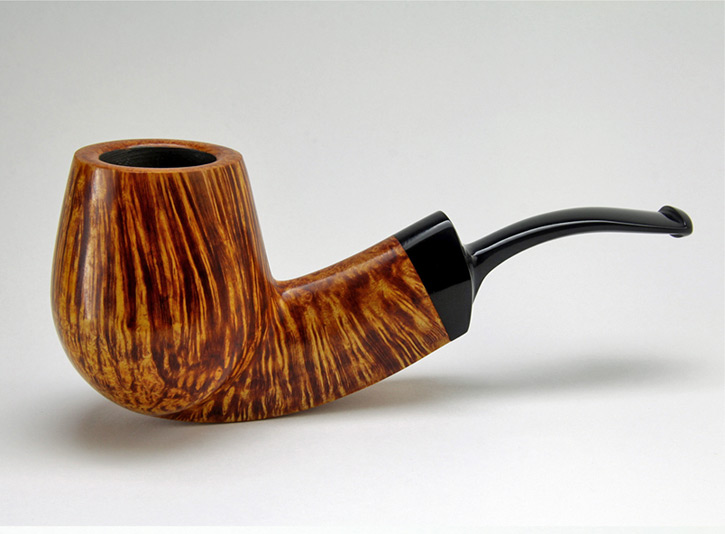
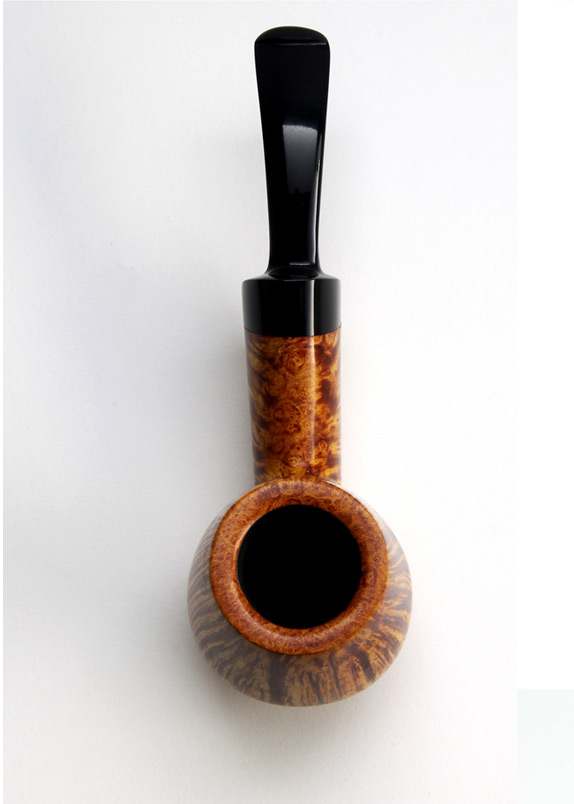
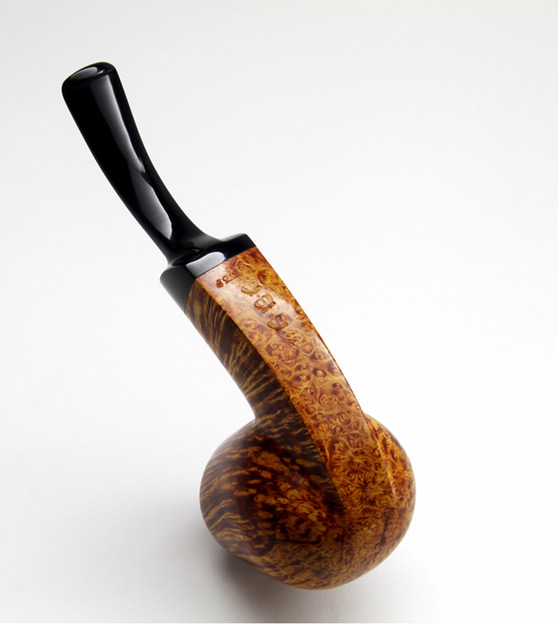


High-grade Joura pipes from a recent catalog.
Photos by Peter Frey, www.rehprodukt.de
Karlo came to the Chicago Pipe Show in 2001, and I remember our first meeting. The pre-show was in the New Orleans Room and I was walking down an aisle glancing at the thousands of pipes on display. Suddenly I stopped — because I was looking at so many beautiful pipes on one table. I said hello to the white-haired gentleman sitting there and asked if he had made the pipes. He spoke no English and I no German, but fortunately a translator appeared. I bought two pipes on the spot — in the $400 range in those days. I stayed in touch with Karlo and visited him in Bremen the following year, which was the basis for the profile I wrote of him in "In Search of Pipe Dreams." The television story about Joura that was being shot during my visit is available on YouTube (titled "Joura, Filmed in 2002").
I saw Karlo at a pipe show in Cuxhaven, Germany, in 2004 and a few years later at a show in Würselen, Germany. After that, we lost touch for a number of years.
His pipes were selling well in America through the efforts of David Field and Marty Pulvers, and they did a fantastic job getting them into many brick and mortar pipe stores. Ernie Markle, the exceptionally talented young American pipe maker, told me that the first high-grade pipe he ever saw was a Joura pipe at his local tobacconist in Phoenix, Arizona. The fact that such a pipe was in that store in the first place is a great tribute to David Field and Marty Pulvers.
Over the past 10 years, most of the Joura pipes have been sold in China, and a handful for incredibly high prices, including a few for more than $10,000. There was another German television profile of Karlo featuring an enthusiastic reporter who was thrilled to meet the great Joura (search YouTube using the phrases "Tach Auch" and "Joura in Bremen" to see footage).
Shortly before the 2015 Chicago Pipe Show I was chatting with a fellow collector who wanted to buy Joura pipes but couldn’t find them. I wrote to Karlo and heard back from his oldest daughter, Kim, who is handling the business side for his pipes. Kim said they were considering coming to the Chicago show. Kim hates to fly but her younger sister, Coco, was eager to make her first trip to America. Fortunately, all three of Karlo’s children speak English.

Kim Joura, who is selling Karlheinz Joura pipes.
I first met Coco when she was 12, in 2002, but I recognized her immediately at the Pheasant Run Resort. She is a 25-year-old opera singer who is studying for her master’s degree. She brought some of Karlo’s pipes and sold them mostly to Chinese buyers.

Rick Newcombe and Coco Joura at the 2015 Chicago Pipe Show with Joura pipes displayed on the table.
The market has changed, and I have noticed that most high grade pipes are sold on a handful of websites based in cities that are spread all over the world. Kim sells Joura pipes through some of these websites, such as Per Bilhall’s website from Sweden: http://scandpipes.com/group.asp?group=640. Kim also sells directly to customers through the "Pipeshop" section of her website: http://www.joura-pipeshop.de/index.php/component/virtuemart/polierte-pfeifen.
The fact that a few Joura pipes have sold for mega bucks has scared off some collectors from even looking, but there are pipes on the Joura website priced at 560 Euros. Many are in the $1,500 range. The pipes are frequently stamped with the year Karlo bought the briar. I suggested that he include the year the pipe was made, so, for instance, if he bought the briar in 1978 and made the pipe in 2015, he might have a stamp saying 78/15. It is not an important issue to me because I rarely pay attention to stampings on pipes, but obviously many collectors do. There is a whole range of classifications of Joura pipes involving crowns, letters and numbers. If you are interested in the details, I’m sure Kim will be happy to fill you in if you contact her through their website.
During the Chicago show, Romeo Domenico, a seller of briar to pipe makers, came over to our table with a big grin on his face. Romeo, who goes by the nickname "Mimmo," was so happy to see Coco! What amazed me was her ability to speak Italian with him as if she were a native. She explained that her boyfriend was Italian and it was easy for her to become fluent. Coco said she and Mimmo first met when her family stayed in an apartment in Italy for several weeks when she was a baby and Mimmo was a teenager, when Karlo was buying briar from Filippo Romeo, Mimmo’s father. He started buying from Filippo Romeo in 1974; hence, some of Joura’s pipes are called "Romeos" because they were made with that very old briar.
In August 2015 I visited the Jouras in Bremen. Coco was in Italy so I spent time with Karlo and his two other children, Kim and Fabian. I first met Fabian when he was an 8-year-old boy. He is now 21 and a college student majoring in physics with the goal of becoming a high school physics teacher and … a pipe maker. Fabian started working with his father three years ago, and he has keen eyes and great hands. His father has taught him every pipe-making trick imaginable, and Fabian’s pipes reflect a professionalism beyond his years. The nomenclature is the name "Joura" in a circle, with an F stamped at the base of the circle. I bought one and am very happy with it. If you are interested in Fabian’s pipes, I’d suggest contacting Kim.

Fabian Joura sanding the mouthpiece on one of his pipes.

A new pipe made by Fabian Joura, who is working with his father.
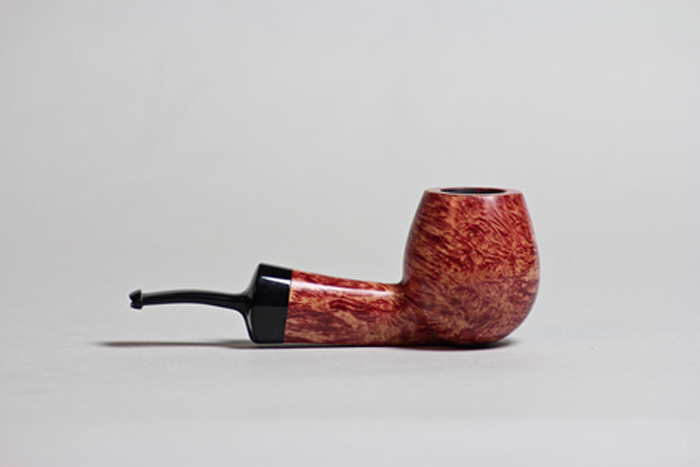
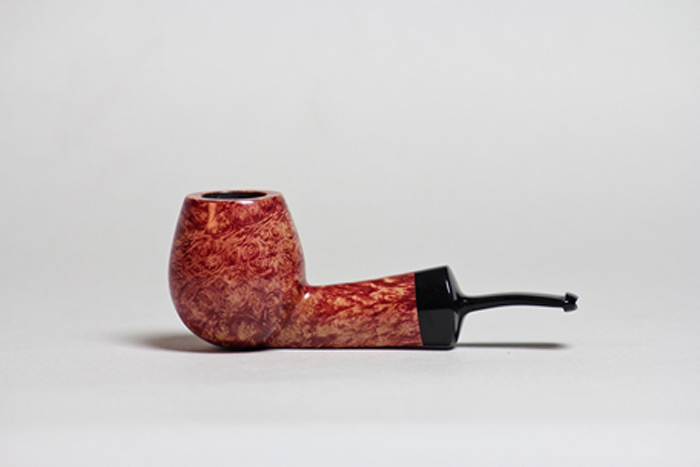
A Fabian Joura pipe with a unique and beautiful stain.
When Karlo, Fabian and I were in the workshop, I brought out a handful of my Joura pipes that needed slight tweaks. These were mostly pipes that I had bought on eBay and for which I had new mouthpieces made, and one was an old favorite that I had bought from Josef Ostermann’s pipe store in Vienna years ago, and the mouthpiece had become pretty ragged. Two of the repairs were by Brian McNulty and one by George Dibos. Both are talented Americans who I highly recommend for repairs, and Karlo was very complimentary of their work. Karlo re-stamped the name "Joura” on two of the pipes because it had become faded, and he sanded off a little vulcanite on the saddle of one of the pipes to make it look more like the original. As I watched him work, I was so impressed by his relaxed skill — just an amazing pipe maker.

An older Joura pipe with a replacement mouthpiece by Brian McNulty of Los Angeles.

One of my favorite Joura pipes with a replacement mouthpiece by George Dibos of Kansas City.
Fabian lives in an apartment across the river from Karlo’s house, and he rides his bicycle to the workshop every morning. Karlo also continues to ride his bicycle every day. After making pipes in the morning, he rides to a restaurant with a view of the river and enjoys a cup of hot coffee while watching the water, contemplating, relaxing and just enjoying his life.
There is a possibility that Kim, Coco and Fabian will all travel to the 2016 Chicago Pipe Show. I hope so. But whether they do or not, it is worth checking out Joura pipes if you are looking for high grades with an unusual flair and fantastic old wood. Pipedia says, “Today, most American collectors rank Joura pipes as among the very best, comparing well to pipes by S. Bang, Baldo Baldi and other world-class artisans."
Karlo is very relaxed today, at 73, making pipes out of desire and not necessity, proud of his talented children, knowing that his legacy will live on. He has been amply rewarded for his tremendous courage to follow his dreams.

Kim, Karlo and Fabian Joura in Bremen, Germany in August 2015. Coco was in Italy during my visit.


















Wonderful, evocative writing and photos of an inspiring story.
hp
les
This beautifully written piece by Rick Newcombe shows why he is master craftsman and artisan of pipe lore and non-fiction.
He is the virtuoso of pipe literature and the most talented of pipe writers writing today.
This story of a very brave man and friends is just a pleasure to read, and is a wonderful account of a world-class pipe maker.
This is a top-drawer article that I enjoyed very much. As much as we all love pipes the great stories are always about the people.
Now I have to figure out how to acquire one of these beauties even though they are out of my price range.
Rick,
I should of mentioned that directly behind you in the photo of you and CoCo is George Dibos.
LOL So it is.
I remember that moment. The guy with the beard was saying, “Sir, I agree that the button isn’t quite symmetrical. I see it, OK? Really. Now, if you don’t put that down, I’m afraid I’m going to have to call security.”
Great story, Rick
Dave
Rick, what an awesome piece. A great story of overcoming diversity. All the pictures were really a plus in getting to know more about Karlheinz Joura and his family. Pipes to dream of.
Dear Mr Newcombe, Thanks very much for your good article and pictures! Can I translate it to Chinese and submit it to public web? I think it will help many pipe smokers understand Mr Joura and his pipes. Thanks.
To Old Ghost: Yes, you can translate it and submit the Chinese version to public web, provided that you credit pipesmagazine.com and provide a link to it. I’m sure Kevin Godbee would love to have more readers in China. I love the idea of circulating a pro-freedom message in China.
The level of expertise and experience brought to the pipe world by those such as Mr. Joura and Mr. Newcombe is a delight, and in the case of the former, to behold.
Great Story about a great family man whose children have taken pride in their dads work. I wish that this was the way more American children would follow their parents into a family business.
Jon